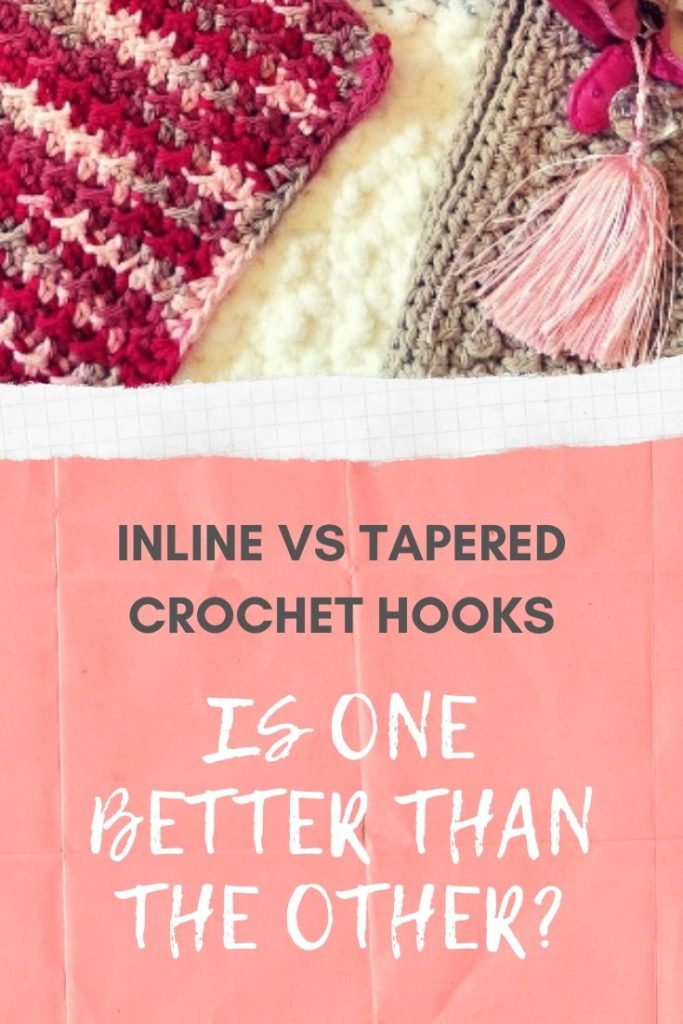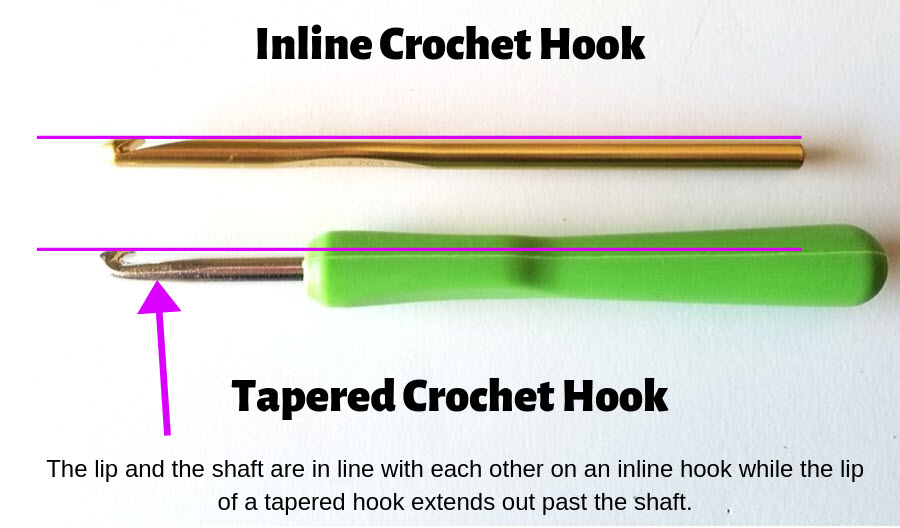
There are two types of standard crochet hooks – inline vs. tapered.
How do they compare and, more importantly, is one really better than the other?
There are some differences but they may not matter to you at all and they might not have any impact on your finished results at all.
Inline crochet hooks are called such because the hook head is “in line” with the shaft. Susan Bates Silvalume hooks are inline. The head is slightly more pointed and the bowl or mouth is a little deeper.
Tapered hooks have a hook head that extends out past the shaft and is a little more rounded. The bowl or mouth might not be as deep as the bowl on an inline hook.

Since inline hooks have a hook head that is in line with (and the same width as) the shaft and the shaft determines the size of your stitches it makes sense that inline hooks are sometimes recommended for those who are struggling to create uniform stitches.
The deeper lip of an inline hook may help beginners maintain better control of their yarn when pulling through a stitch. Sometimes when I’m working with a medium yarn and a tapered hook I find I frequently lose the yarn as I’m pulling it through. The deeper lip of an inline hook could resolve that issue.
However, I personally find that an inline hook can have such a deep groove that I have to twist the hook more than I would a tapered hook in order to complete a stitch. My wrists don’t like that much at this age (not that I’m ancient, mind you, but between carpal tunnel and some developing arthritis I don’t need the additional hassle!).
Therefore, while I learned to crochet on an old set of aluminum, inline hooks (and still have them) I only use tapered hooks these days.
Pros of an Inline Hook
- May help create evenly sized stitches more consistently
- May provide more control over tension
- Might help penetrate tighter stitches more easily due to the slightly more pointed head
Pros of a Tapered Hook
- May aid in crocheting more quickly
- Might not split your yarn as often
- Might result in less wrist pain
See all those “mays” and “mights”? That means those differences might be so small that they may not matter to you at all.
What it really boils down to is whether you personally have a preference for one type of hook over the other. Because everyone has some unique twist to how they hold or use their hook the type that works best for one person might not work as well for someone else. You can see my list of the best hooks here.
I, personally, prefer to look at the different parts of the hook and choose the ones I want to use based on my design preferences for those parts. Most of the time I lean towards tapered hooks but if there was an inline hook with a great handle, a slightly rounded head, and the right shaped bowl then it could certainly become a go-to favorite!

How about including a picture of both hooks. That would be helpful.
Thank you
Kathy, there is a picture comparing the two but it’s set to delay loading until you scroll down the page. It should pop up when you come to it but if you’re not seeing it scroll further down the page and then back up. Let me know if that doesn’t work for you. Thanks!
I want to thank you on your in-depth report on crochet hooks. Especially clearly explaining the difference between inline and tapered hooks. The part I’m confused about is your 5 hooks were all tapered. I hold my hook the pencil way and if my style of holding a hook would be as comfortable with the tapered design. I’m wondering if a comparison of the hooks — tapered vs. inline and the knife hold vs. the pencil hold would come out differently or be the same. For me it might not make a difference because I prefer Susan Bates over Boye?
Again, thank you for this wonderful explanation of crochet hooks. I did learn a lot. Barbara
Barbara, thank YOU for the compliment! What a great question. I’ve made a note to myself to run a similar test for inline hooks using both holding methods – although I’ll have to practice up on the pencil hold. 😉
I’d have to say it does make a difference.
Tapered hooks work better for knife hold crocheters.Inline hooks work better for pencil style crocheters.The difference truly shows in medium to small yarn.
Tapered hooks are why I learned to use both styles.
Tapered hooks slip too much for pencil style.
This will slow you down frustrating you.
It will be hard to maintain gauge as well.
I had to learn knife hold to use tapered hooks.
The knife hold causes pain due to unnatural grip in some crocheted myself included.
If you have small hands you will definitely dislike tapered hooks.In addition to slipping you will also have a long hook which also is a true pain for small hands
Erica I love crochting and with keep in touch with you. sue
There is also a huge difference when doing certain stitches. For example I find it completely impossible to do bullion stitches with anything other than an inline hook!
That’s a very good point! I’ve been working with cotton thread lately and had to switch to an older metal hook in order to more quickly get through the stitches.
For me I use both …if I am working with cotton or a 3 ply yarn ..then I use the inline ..it holds the stitch better for me
I’ve been crocheting for 50 years and just today have a pattern asking for 2 same size hooks, but one inline. . I have bundles of hooks, some going back a generation and I now know why I tend to choose different same size hooks for various projects. I had no idea why I do that until now. Thanks for this explanation
It also depends on the style of crocheting. I find tapered hook ends to be horrible for Tunisian crochet, especially Tunisian mosaic technique. The heads are too rounded to easily find the TSSEX ch1 stitch at the start of a row, and the ends of the heads too short to hold onto the yarn for return passes. They are slower, but for me, crochet is a meditative process, not a speed challenge.
For ‘regular’ crochet, which is mostly mosaic overlay in the round, ergonimic tapered hooks work fine, IF they have enough point on the end. I still dislike the perfectly rounded ends and don’t understand how they are supposed to go under yarn. They may not ‘split the yarn’ for some, but they do for me.
As to wrist pain, any crochet technique is possible, especially if someone holds their work without supporting both it and that arm, making the wrist do all the work. A pillow under the arm holding the hook may help a lot. Daughter is a PT doc and has worked to find ways to help crocheters and knitters keep on, without having to stop because of pain. She also recommends stretching every 30 minutes, which most do not bother with, until they get hurt.
She’s also found that crocheters that hold in the knife method are less likely to be patients than those who hold it across the top of the hand.
It all comes down to what works for you is great, in the end, and if it doesn’t work, there are changes that can be made.
I always used tapered hooks, I thought I liked them best. Though at 7 I probably learned to crochet with an inline hook. However I have started using an in-line hook for making stuffed toys. The stitches are so tight that an in-line hook works much better and is less likely to split the yarn. So I’ve become a convert.
Kathleen, I just made my first few crochet toys last year and I could see where the type of project one is doing might call for a different style of hook. That’s a great point!